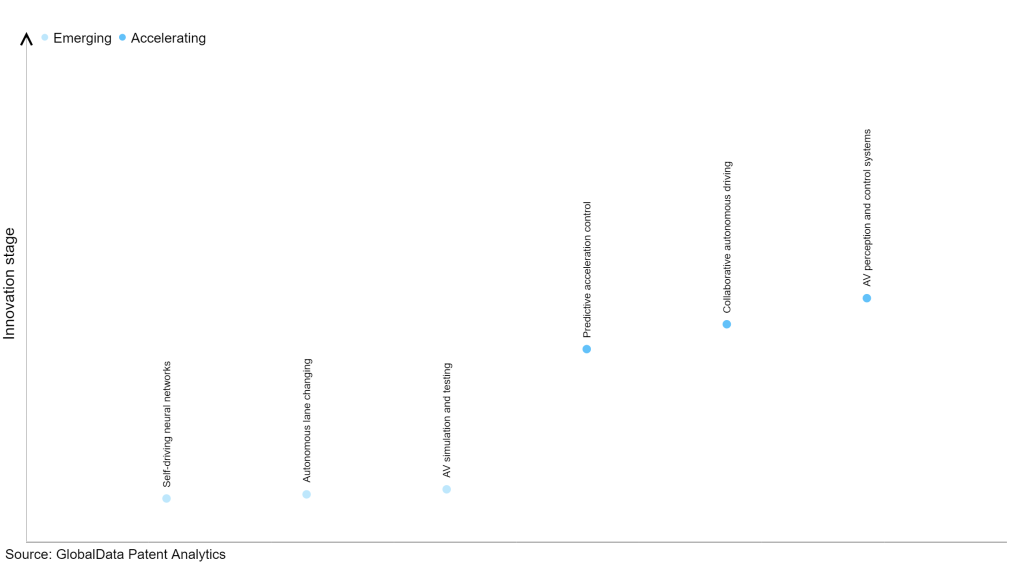The automotive industry continues to be a hotbed of patent innovation. Activity is driven by the increasing number of accidents and rising distractions while lane changing. To enhance vehicle safety, comfort, and efficiency, vehicle lane-changing behavior is influenced by the surrounding traffic environment and flow. This enables the vehicle to make more informed decisions when it comes to changing lanes. Furthermore, growing importance of technologies such as collision avoidance system, traffic sign recognition system, tire pressure monitoring system, and parking assistance systemis driving innovation in the industry. In the last three years alone, there have been over 720,000 patents filed and granted in the automotive industry, according to GlobalData’s report on Artificial intelligence in automotive: autonomous lane changing. Buy the report here.

Discover B2B Marketing That Performs
Combine business intelligence and editorial excellence to reach engaged professionals across 36 leading media platforms.
However, not all innovations are equal and nor do they follow a constant upward trend. Instead, their evolution takes the form of an S-shaped curve that reflects their typical lifecycle from early emergence to accelerating adoption, before finally stabilizing and reaching maturity.
Identifying where a particular innovation is on this journey, especially those that are in the emerging and accelerating stages, is essential for understanding their current level of adoption and the likely future trajectory and impact they will have.
300+ innovations will shape the automotive industry
According to GlobalData’s Technology Foresights, which plots the S-curve for the automotive industry using innovation intensity models built on over one million patents, there are 300+ innovation areas that will shape the future of the industry.
Within the emerging innovation stage, self-driving neural networks, autonomous lane changing and AV simulation and testing are disruptive technologies that are in the early stages of application and should be tracked closely. Predictive acceleration control, collaborative autonomous driving, and AV perception and control systems are some of the accelerating innovation areas, where adoption has been steadily increasing.
Innovation S-curve for artificial intelligence in the automotive industry

Autonomous lane changing is a key innovation area in artificial intelligence
Autonomous lane changing is the ability of a self-driving vehicle to change lanes on its own without any input from the driver or human operator. The technology incorporates sensors, algorithms, and decision-making models to calculate the safest and quickest possible lane change for the vehicle.
GlobalData’s analysis also uncovers the companies at the forefront of each innovation area and assesses the potential reach and impact of their patenting activity across different applications and geographies. According to GlobalData, there are 90+ companies, spanning technology vendors, established automotive companies, and up-and-coming start-ups engaged in the development and application of autonomous lane changing.
Key players in autonomous lane changing – a disruptive innovation in the automotive industry
‘Application diversity’ measures the number of applications identified for each patent. It broadly splits companies into either ‘niche’ or ‘diversified’ innovators.
‘Geographic reach’ refers to the number of countries each patent is registered in. It reflects the breadth of geographic application intended, ranging from ‘global’ to ‘local’.
Intel is one of the leading patent filers in autonomous lane-changing technology. Intel's latest autonomous lane-changing technology is named Mobileye SuperVision, which is a camera-based system that uses artificial intelligence (AI) to detect and track other vehicles, pedestrians, and cyclists on the road. Mobileye SuperVision can make decisions about when to change lanes safely, without the need for human intervention. Some other key patent filers in autonomous lane changing include Baidu, INRIX, and Nissan Motor
In terms of application diversity, INRIX leads the pack, while Porsche Automobil and Telefonaktiebolaget LM Ericsson stood in the second and third positions, respectively. By means of geographic reach, Intel held the top position, followed by INRIX and Peloton Technology.
To further understand the key themes and technologies disrupting the automotive industry, access GlobalData’s latest thematic research report on Artificial Intelligence (AI) in Automotive.
Data Insights
From

The gold standard of business intelligence.
Blending expert knowledge with cutting-edge technology, GlobalData’s unrivalled proprietary data will enable you to decode what’s happening in your market. You can make better informed decisions and gain a future-proof advantage over your competitors.





